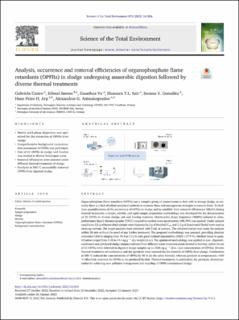| dc.contributor.author | Varela, Gabriela Castro | |
| dc.contributor.author | Sørmo, Erlend | |
| dc.contributor.author | Yu, Guanhua | |
| dc.contributor.author | Sait, Shannen Thora Lea | |
| dc.contributor.author | Villa Gonzalez, Susana | |
| dc.contributor.author | Arp, Hans Peter Heinrich | |
| dc.contributor.author | Asimakopoulos, Alexandros | |
| dc.date.accessioned | 2023-08-14T10:56:27Z | |
| dc.date.available | 2023-08-14T10:56:27Z | |
| dc.date.created | 2023-03-03T11:18:42Z | |
| dc.date.issued | 2023 | |
| dc.identifier.citation | Science of the Total Environment. 2023, 870 . | en_US |
| dc.identifier.issn | 0048-9697 | |
| dc.identifier.uri | https://hdl.handle.net/11250/3083786 | |
| dc.description.abstract | Organophosphate flame retardants (OPFRs) are a complex group of contaminants to deal with in sewage sludge, as currently there is a lack of robust analytical methods to measure them and management strategies to remove them. To facilitate quantifications of the occurrence of OPFRs in sludge and to establish their removal efficiencies (REs%) during thermal treatments, a simple, reliable, and rapid sample preparation methodology was developed for the determination of 21 OPFRs in diverse sludge, ash and biochar matrices. Matrix-solid phase dispersion (MSPD) tailored to ultra-performance liquid chromatography (UPLC) coupled to tandem mass spectrometry (MS/MS) was applied. Under optimal conditions, 0.5 g of freeze-dried sample were dispersed in 2 g of Bondesil C18, and 1.5 g of deactivated florisil were used as clean-up sorbent. The target analytes were extracted with 5 mL of acetone. The obtained extract was ready for analysis within 20 min without the need of any further treatment. The proposed methodology was assessed, providing absolute recoveries (Abs%) ranging from 50.4 to 112 % with good method repeatability (RSDs <17.9 %). Method limits of quantification ranged from 0.10 to 14.0 ng g−1 dry weight (d.w.). The optimized methodology was applied to raw-, digested-, combusted and pyrolyzed sludge samples collected from different waste treatment plants located in Norway, where 16 out of 21 OPFRs were detected in digested sludge samples up to 2186 ng g−1 (d.w.; sum concentration of OPFRs). Diverse thermal treatments of combustion and dry pyrolysis were assessed for the removal of OPFRs from sludge. Combustion at 300 °C reduced the concentrations of OPFRs by 98 % (in the ashes formed), whereas pyrolysis at temperatures >500 °C effectively removed the OPFRs in the produced biochar. Thermal treatments, in particularly dry pyrolysis, showed potential for achieving zero pollution management and recycling of OPFR contaminated sludge. | en_US |
| dc.language.iso | eng | en_US |
| dc.publisher | Elsevier | en_US |
| dc.rights | Navngivelse 4.0 Internasjonal | * |
| dc.rights.uri | http://creativecommons.org/licenses/by/4.0/deed.no | * |
| dc.title | Analysis, occurrence and removal efficiencies of organophosphate flame retardants (OPFRs) in sludge undergoing anaerobic digestion followed by diverse thermal treatments | en_US |
| dc.title.alternative | Analysis, occurrence and removal efficiencies of organophosphate flame retardants (OPFRs) in sludge undergoing anaerobic digestion followed by diverse thermal treatments | en_US |
| dc.type | Peer reviewed | en_US |
| dc.type | Journal article | en_US |
| dc.description.version | publishedVersion | en_US |
| dc.source.pagenumber | 0 | en_US |
| dc.source.volume | 870 | en_US |
| dc.source.journal | Science of the Total Environment | en_US |
| dc.identifier.doi | 10.1016/j.scitotenv.2023.161856 | |
| dc.identifier.cristin | 2130964 | |
| dc.relation.project | Norges forskningsråd: 302371 | en_US |
| dc.relation.project | Norges forskningsråd: 299070 | en_US |
| cristin.ispublished | true | |
| cristin.fulltext | original | |
| cristin.qualitycode | 2 | |

